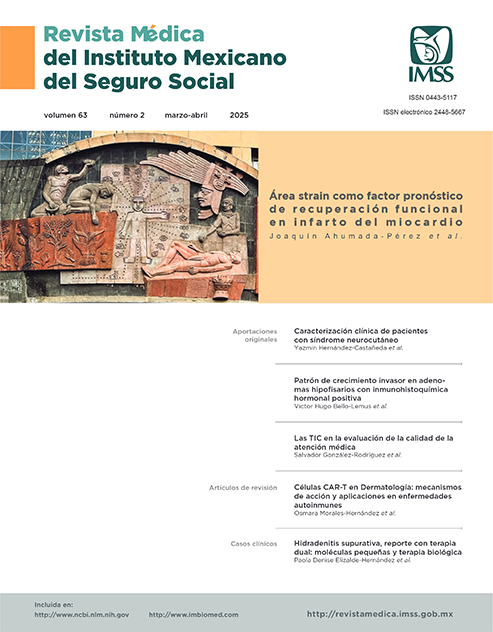CAR-T cells in Dermatology: Mechanisms of action and applications in autoimmune diseases
Main Article Content
Keywords
Immunotherapy, Adopted, Skin Diseases, Autoimmune Diseases, Dermatology, Immunotherapy
Abstract
Abstract
Chimeric Antigen Receptor T (CAR-T) cells have revolutionized the treatment of hematological malignancies and are expanding into autoimmune rheumatological diseases. In dermatology, they open a new therapeutic field for autoimmune disorders.
The aim of this article is to evaluate the mechanisms of action and therapeutic applications of CAR-T cells in autoimmune dermatological diseases, exploring the challenges and future perspectives for their clinical application.
A thorough review was conducted in PubMed of preclinical and clinical studies on the application of CAR-T in dermatological diseases, selecting articles from the last 5 years with a focus on autoimmune diseases.
The potential of CAR-T cells in autoimmune dermatological diseases is highlighted, such as in pemphigus vulgaris, where CAR-T cells targeting pathogenic anti-Dsg3 B cells have shown efficacy. In cutaneous lupus erythematosus, CAR-T cells directed at CD19 have achieved significant clinical remissions. Additionally, applications in psoriasis and melanoma are explored, although efficacy is limited by adverse factors.
CAR-T therapy represents a promising option for the management of refractory dermatological diseases, with favorable results in preclinical and clinical models. However, its clinical implementation faces challenges such as optimizing safety and reducing off-target effects. Future research should focus on next-generation CARs and clinical trials that validate their efficacy and safety profile in dermatology.
References
Sadelain M, Brentjens R, Rivière I. The basic principles of chimeric antigen receptor design. Cancer Discov. 2013;3(4):388-98. doi: 10.1158/2159-8290.CD-12-0548.
Uslu U. Driving CAR T cells towards dermatologic oncology. J Dtsch Dermatol Ges. 2021;19(3):359-62. doi: 10.1111/ddg.14402.
Simon B, Uslu U. CAR-T cell therapy in melanoma: A future success story? Exp Dermatol. 2018;27(11):1315-21. doi: 10.1111/exd.13792.
Chen L, Chen F, Li J, et al. CAR-T cell therapy for lung cancer: Potential and perspective. Thorac Cancer. 2022;13(7):889-99. doi: 10.1111/1759-7714.14375.
Maus MV, Levine BL. Chimeric Antigen Receptor T-cell Therapy for the Community Oncologist. Oncologist. 2016;21(5):608-17. doi: 10.1634/theoncologist.2015-0421.
Zhao Z, Chen Y, Francisco NM, et al. The application of CAR-T cell therapy in hematological malignancies: advantages and challenges. Acta Pharm Sin B. 2018;8(4):539-51. doi: 10.1016/j.apsb.2018.03.001.
Maalej KM, Merhi M, Inchakalody VP, et al. CAR-cell therapy in the era of solid tumor treatment: current challenges and emerging therapeutic advances. Mol Cancer. 2023;22(1):20. doi: 10.1186/s12943-023-01723-z.
Chung JB, Brudno JN, Borie D, et al. Chimeric antigen receptor T cell therapy for autoimmune disease. Nat Rev Immunol. 2024;24(11):830-45. doi: 10.1038/s41577-024-01035-3.
Yang Z, Liu Y, Zhao H. CAR T treatment beyond cancer: Hope for immunomodulatory therapy of non-cancerous diseases. Life Sci. 2024;344:122556. doi: 10.1016/j.lfs.2024.122556.
Pan K, Farrukh H, Chittepu VCSR, et al. CAR race to cancer immunotherapy: from CAR T, CAR NK to CAR macrophage therapy. J Exp Clin Cancer Res. 2022;41(1):119. doi: 10.1186/s13046-022-02327-z.
Grando SA. Pemphigus autoimmunity: hypotheses and realities. Autoimmunity. 2012;45(1):7-35. doi: 10.3109/08916934.2011.606444.
Ellebrecht CT, Maseda D, Payne AS. Pemphigus and pemphigoid: From disease mechanisms to druggable pathways. J Invest Dermatol. 2022;142(3 Pt B):907-14. doi: 10.1016/j.jid.2021.04.040.
Bieber K, Kridin K, Emtenani S, et al. Milestones in personalized medicine in pemphigus and pemphigoid. Front Immunol. 2021;11:591971. doi: 10.3389/fimmu.2020.591971.
Abulikemu K, Hu F, Liang J, et al. Targeting therapy in pemphigus: Where are we now and where are we going? Heliyon. 2023;9(6):e16679. doi: 10.1016/j.heliyon.2023.e16679.
Műzes G, Sipos F. CAR-based therapy for autoimmune diseases: A novel powerful option. Cells. 2023;12(11):1534. doi: 10.3390/cells12111534.
Ermiş Akkuş H. Treatment of pemphigus beyond rituximab: chimeric autoantibody receptor T cell (CAAR-T cell) therapy. Mucosa. 2023;6(1):1-9. doi: 10.33204/mucosa.1235968.
Yanovsky RL, McLeod M, Ahmed AR. Treatment of pemphigus vulgaris: part 2 - emerging therapies. Expert Rev Clin Immunol. 2019;15(10):1061-71. doi: 10.1080/1744666X.2020.1672539.
Blache U, Tretbar S, Koehl U, et al.CAR T cells for treating autoimmune diseases. RMD Open. 2023;9(4):e002907. doi: 10.1136/rmdopen-2022-002907.
Pietraforte I, Frasca L. Autoreactive T-cells in psoriasis: Are they spoiled Tregs and can therapies restore their functions? Int J Mol Sci. 2023;24(5):4348. doi: 10.3390/ijms24054348.
Wan S, Xu W, Xie B, et al. The potential of regulatory T cell-based therapies for alopecia areata. Front Immunol. 2023;14:1111547. doi: 10.3389/fimmu.2023.1111547.
Passeron T, King B, Seneschal J, et al. Inhibition of T-cell activity in alopecia areata: Recent developments and new directions. Front Immunol. 2023;14:1243556. doi: 10.3389/fimmu.2023.1243556.
Hao J. Therapeutic cancer vaccines in advanced melanoma: Mechanism, application, and future direction. SPIE. 2023;1261(1):1508-14. doi: 10.1117/12.2669534.
Razavi A, Keshavarz-Fathi M, Pawelek J, et al. Chimeric antigen receptor T-cell therapy for melanoma. Expert Rev Clin Immunol. 2021;17(3):209-23. doi: 10.1080/1744666X.2021.1880895.
Jilani S, Saco JD, Mugarza E, et al.CAR-T cell therapy targeting surface expression of TYRP1 to treat cutaneous and rare melanoma subtypes. Nat Commun. 2024;15(1):1244. doi: 10.1038/s41467-024-45221-2.
Nusbaum KB, Dulmage B, Choi JN, et al. Cutaneous manifestations of chimeric antigen receptor T-cell therapy: An introduction for dermatologists. J Am Acad Dermatol. 2022;87(3):597-604. doi: 10.1016/j.jaad.2021.07.017.
Cruz-Ramos M, García-Foncillas J. CAR-T cell and personalized medicine. Adv Exp Med Biol. 2019;1168:131-45. doi: 10.1007/978-3-030-24100-1_9.
Schett G, Mackensen A, Mougiakakos D. CAR T-cell therapy in autoimmune diseases. Lancet. 2023;402(10416):2034-44. doi: 10.1016/S0140-6736(23)01126-1.
Vukovic J, Abazovic D, Vucetic D, Medenica S. CAR-engineered T cell therapy as an emerging strategy for treating autoimmune diseases. Front Med (Lausanne). 2024;11:1447147. doi: 10.3389/fmed.2024.1447147.


